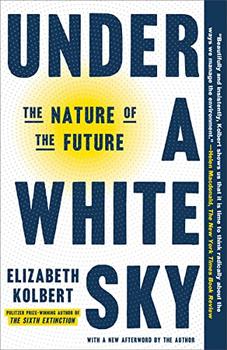Summary | Excerpt | Reviews | Beyond the Book | Readalikes | Genres & Themes | Author Bio

The Nature of the Future
by Elizabeth Kolbert
The reversal of the Chicago was the biggest public-works project of its time, a textbook example of what used to be called, without irony, the control of nature. Excavating the canal took seven years and entailed the invention of a whole new suite of technologies—the Mason & Hoover Conveyor, the Heidenreich Incline—which, together, became known as the Chicago School of Earth Moving. In total, forty-three million cubic yards of rock and soil were gouged out, enough, one admiring commentator calculated, to build an island more than fifty feet high and a mile square. The river made the city, and the city remade the river.
But reversing the Chicago didn't just flush waste toward St. Louis. It also upended the hydrology of roughly two-thirds of the United States. This had ecological consequences, which had financial consequences, which, in turn, forced a whole new round of interventions on the backward-flowing river. It is toward these that City Living is cruising. We're approaching cautiously, though maybe not cautiously enough, because at one point City Living almost gets squished between two double-wide barges. The deckhands yell down instructions that are initially incomprehensible, then become unprintable.
About thirty miles up the down river—or is it down the up river?—we draw near our goal. The first sign that we're getting close is a sign. It's the size of a billboard and the color of a plastic lemon. warning, it says. no swimming, diving, fishing, or mooring. Almost immediately there's another sign, in white: supervise all passengers, children, and pets. Several hundred yards farther along, a third sign appears, maraschino red. danger, it states. entering electric fish barriers. high risk of electric shock.
Everyone pulls out a cell phone or a camera. We photograph the water, the warning signs, and each other. There's joking on board that one of us should dive into the river electric, or at least stick a hand in to see what happens. Six great blue herons, hoping for an easy dinner, have gathered, wing to wing, on the bank, like students waiting on line in a cafeteria. We photograph them, too.
That man should have dominion "over all the earth, and over every creeping thing that creepeth upon the earth," is a prophecy that has hardened into fact. Choose just about any metric you want and it tells the same story. People have, by now, directly transformed more than half the ice-free land on earth—some twenty-seven million square miles—and indirectly half of what remains. We have dammed or diverted most of the world's major rivers. Our fertilizer plants and legume crops fix more nitrogen than all terrestrial ecosystems combined, and our planes, cars, and power stations emit about a hundred times more carbon dioxide than volcanoes do. We now routinely cause earthquakes. (A particularly damaging human-induced quake that shook Pawnee, Oklahoma, on the morning of September 3, 2016, was felt all the way in Des Moines.) In terms of sheer biomass, the numbers are stark-staring: today people outweigh wild mammals by a ratio of more than eight to one. Add in the weight of our domesticated animals—mostly cows and pigs—and that ratio climbs to twenty-two to one. "In fact," as a recent paper in the Proceedings of the National Academy of Sciences observed, "humans and livestock outweigh all vertebrates combined, with the exception of fish." We have become the major driver of extinction and also, probably, of speciation. So pervasive is man's impact, it is said that we live in a new geological epoch—the Anthropocene. In the age of man, there is nowhere to go, and this includes the deepest trenches of the oceans and the middle of the Antarctic ice sheet, that does not already bear our Friday-like footprints.
An obvious lesson to draw from this turn of events is: be careful what you wish for. Atmospheric warming, ocean warming, ocean acidification, sea-level rise, deglaciation, desertification, eutrophication—these are just some of the by-products of our species's success. Such is the pace of what is blandly labeled "global change" that there are only a handful of comparable examples in earth's history, the most recent being the asteroid impact that ended the reign of the dinosaurs, sixty-six million years ago. Humans are producing no-analog climates, no-analog ecosystems, a whole no-analog future. At this point it might be prudent to scale back our commitments and reduce our impacts. But there are so many of us—as of this writing nearly eight billion—and we are stepped in so far, return seems impracticable.
Excerpted from Under a White Sky by Elizabeth Kolbert. Copyright © 2021 by Elizabeth Kolbert. All rights reserved. No part of this excerpt may be reproduced or reprinted without permission in writing from the publisher.
Your guide toexceptional books
BookBrowse seeks out and recommends the best in contemporary fiction and nonfiction—books that not only engage and entertain but also deepen our understanding of ourselves and the world around us.